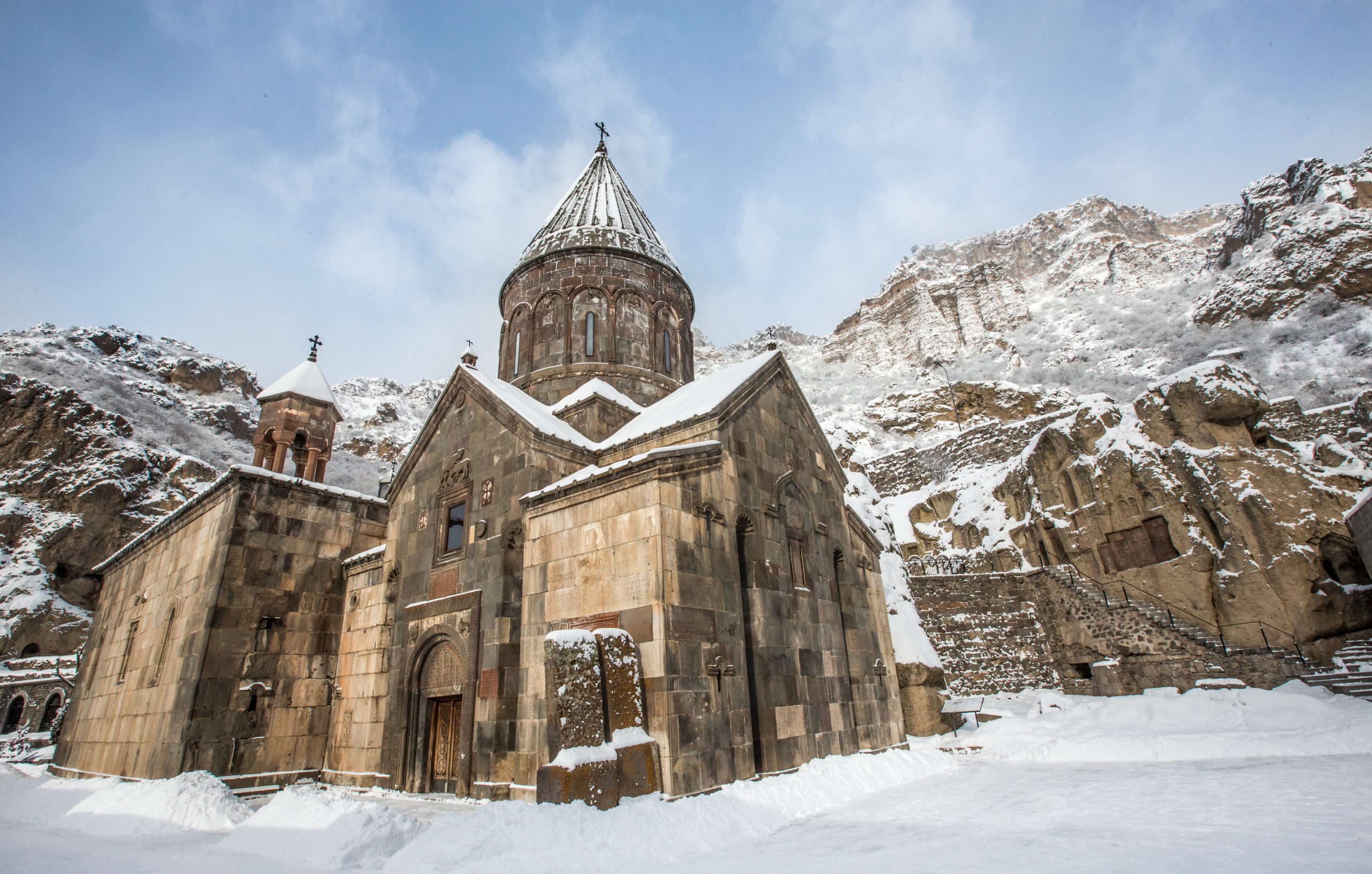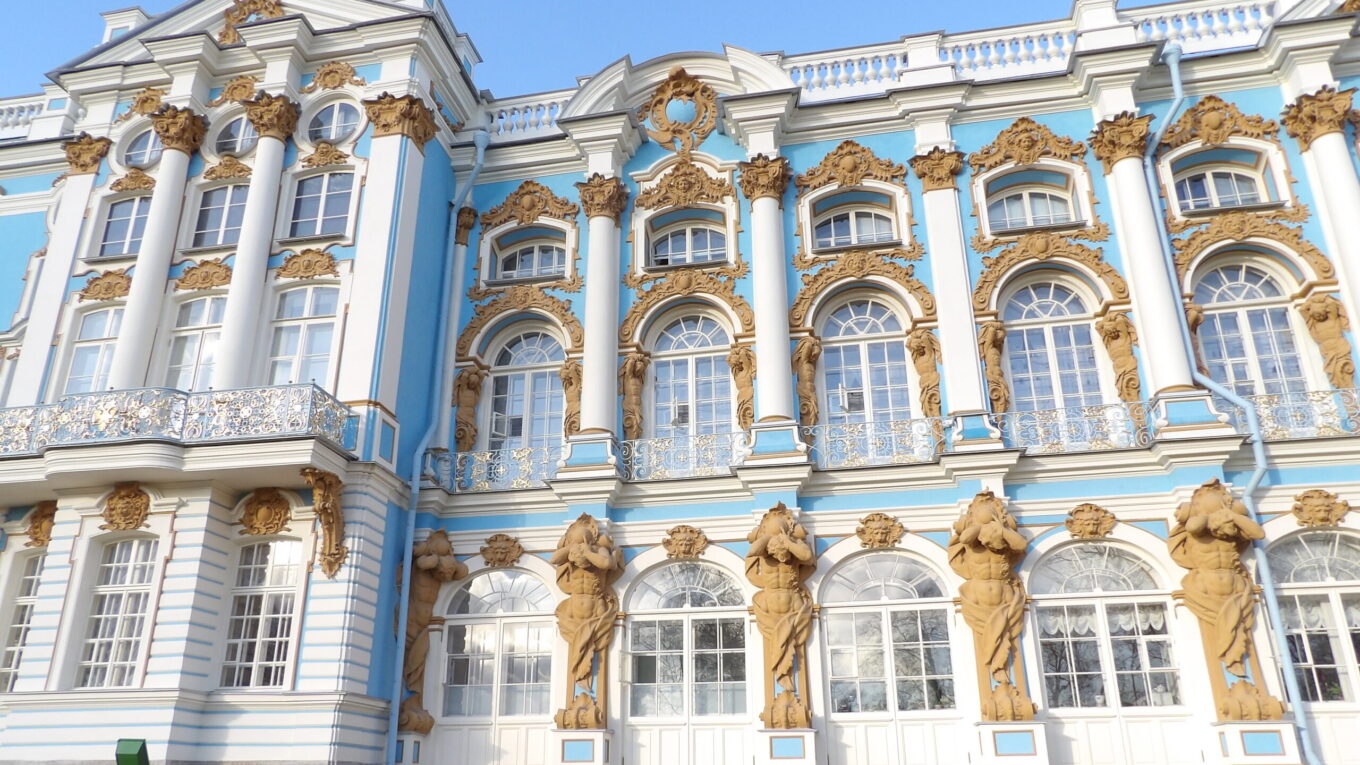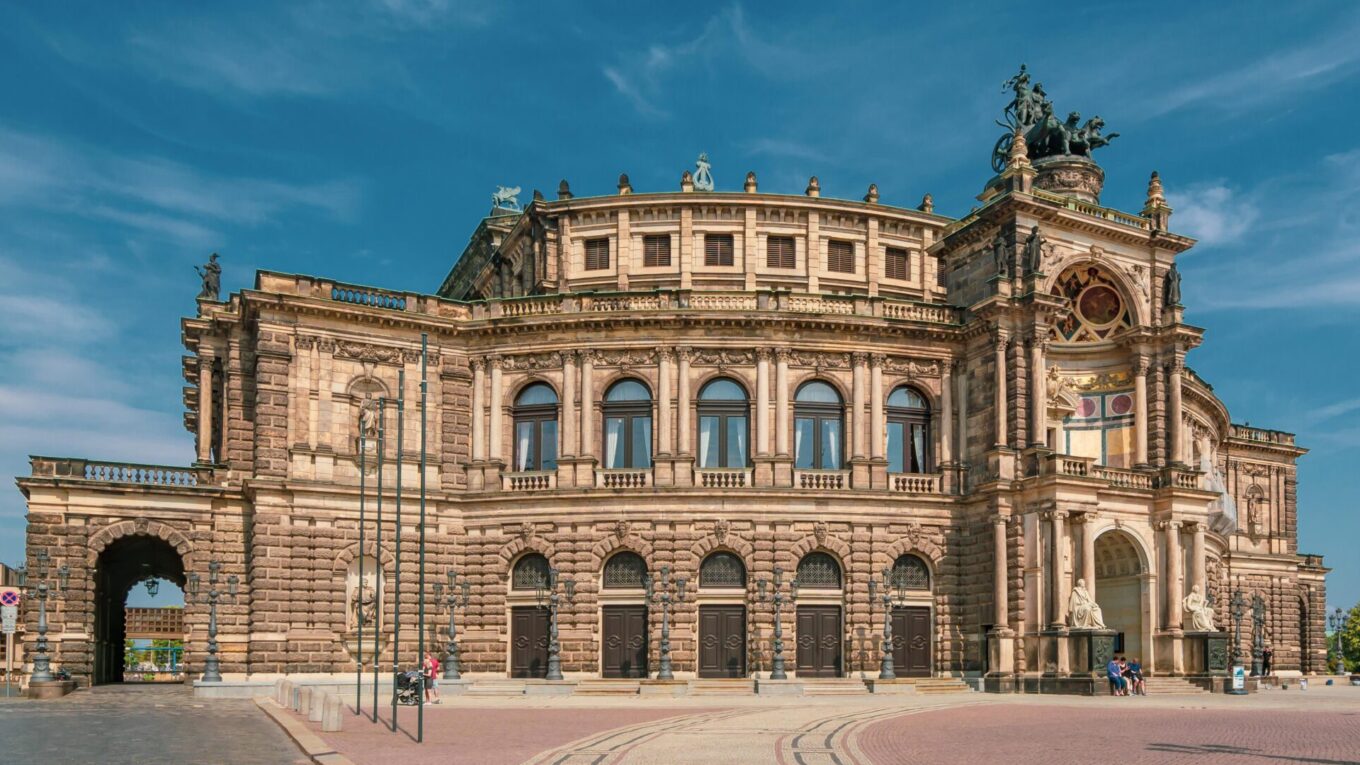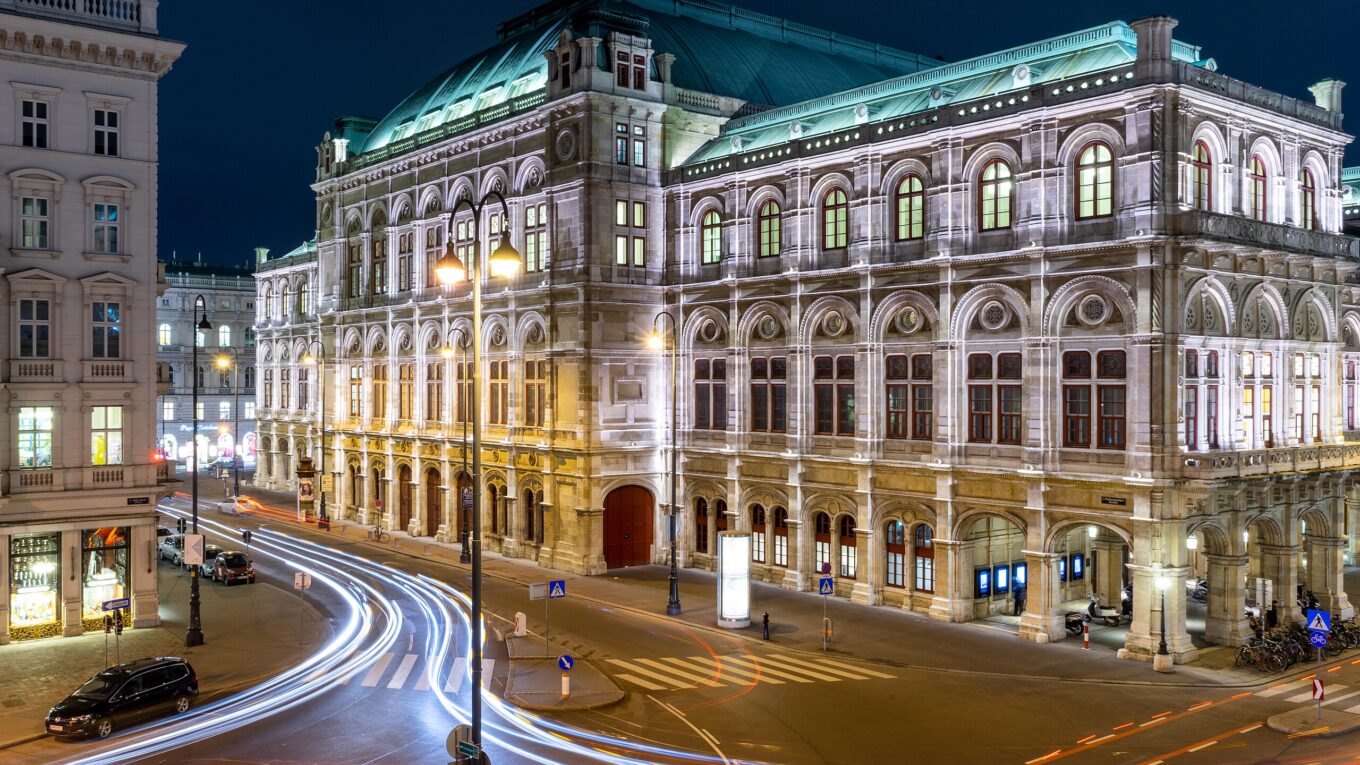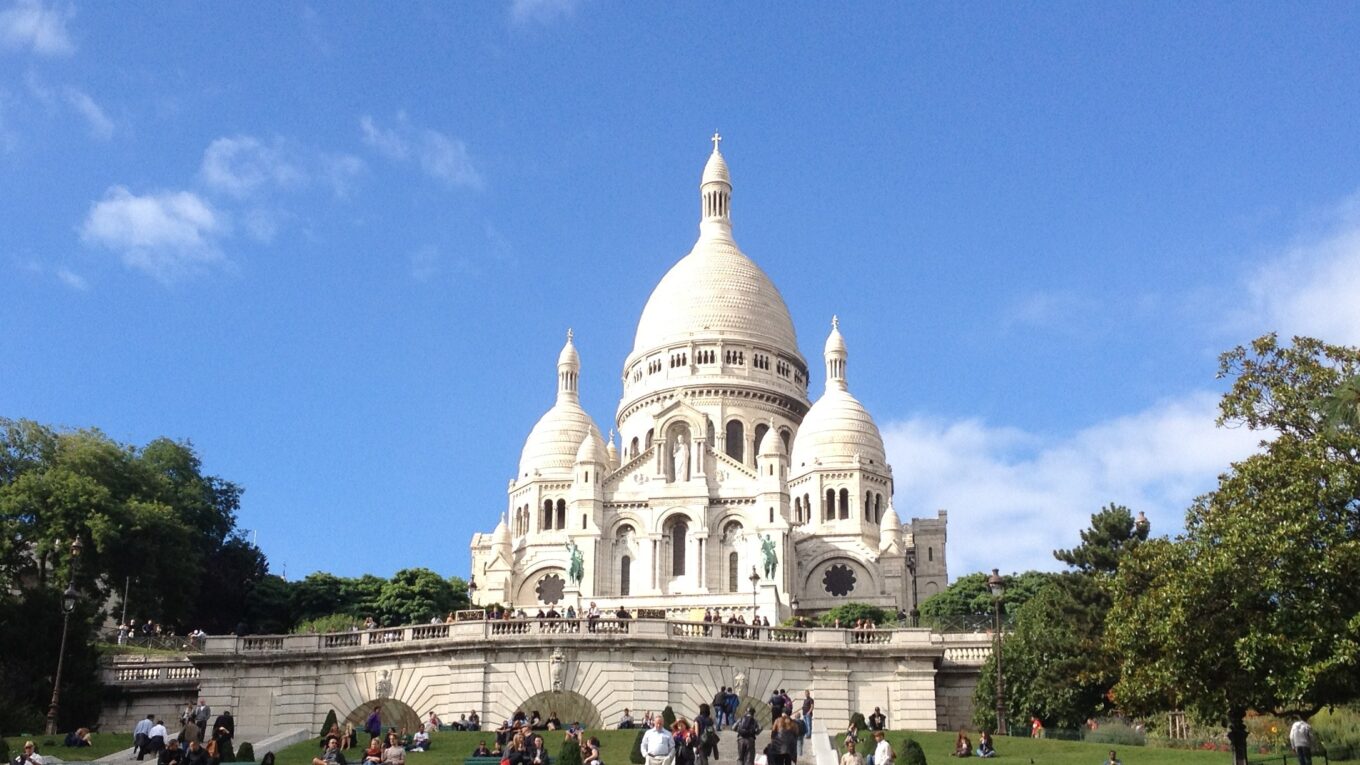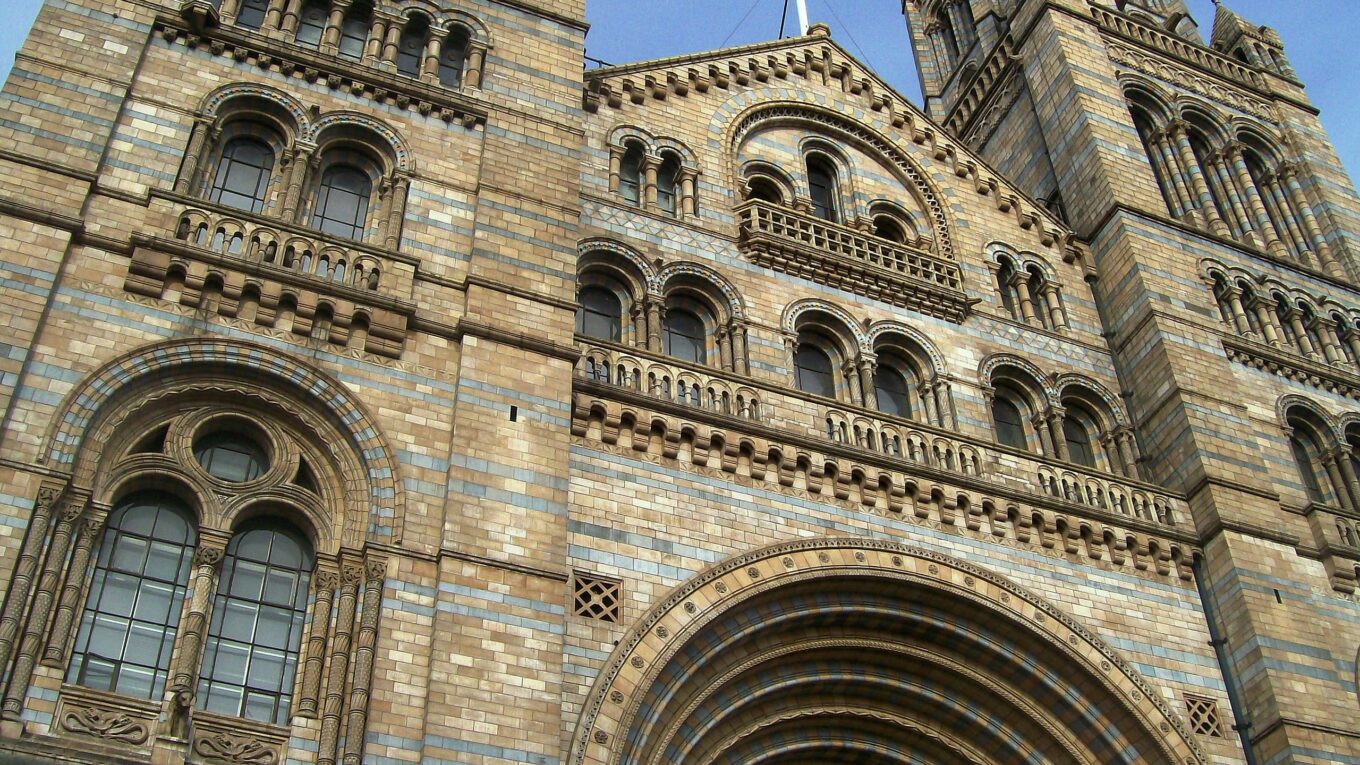Top 15 Examples of Armenian Architecture
The Republic of Armenia is a nation of about three million people located in the Caucasus, a region in between the Black Sea and the Caspian Sea. Armenia was the first nation to officially adopt Christianity in the year 301 CE, and from then on, churches and monasteries became important parts of Armenian Architecture. Many of the world’s oldest Christian buildings were built by the Armenians, and their unique building style is still heavily replicated to this day. Throughout history, Armenia was conquered by many different groups, including the Byzantines, the Arab Caliphates, the Safavid Persians, and the Ottoman Empire. But despite all of the war and conflict, the Armenian people were still able to hang on to their own national identity, which still exists today. Modern Armenia is a prosperous nation that is heavily investing in preserving its historic architecture as well as constructing new modern buildings that allude to the country’s storied past.
History of Armenian Architecture
Armenia has a long and dynamic history going back millennia. The nation’s modern capital, Yerevan, was originally founded in 782 BCE, making it almost 3,000 years old. Armenia wasn’t always an independent nation, however, and it constantly struggled against other regional powers.
Ancient Kingdom of Armenia 321 BCE- 428 CE
The first major period of an independent and unified Armenian nation was the Ancient Kingdom of Armenia. Three different dynasties ruled over the kingdom, which lasted from 321 BCE to 428 CE. This was when Armenia reached its greatest territorial extent, stretching from the Caucasus in between the Black and Caspian Seas all the way down to the Mediterranean. King Tiridates III, made Christianity the state religion in the year 301. Many churches and monasteries, including the world’s oldest cathedral, Etchmiadzin Cathedral, date from this period.
Bagratuni Kingdom of Armenia 885 CE- 1045 CE
Starting in the early 5th century, Armenia came under the control of various rival empires. The Persians, Romans, Byzantines, and Islamic Caliphates each controlled the region to various degrees. Eventually, in 885 CE, thanks to some careful political maneuvering, Armenia once again gained its status as an independent kingdom. They established Ani as their capital, and the city grew into one of the largest cultural and economic centers in the entire region. Eventually, in the middle of the 11th century, the Seljuk Turks invaded and overthrew the last ruler of the Armenian Bagratid Dynasty in 1045 CE.
Armenian Kingdom of Cilicia 1080 CE- 1375 CE
As the Great Seljuk Empire was rapidly expanding, they started raiding Armenian Lands. Many ethnic Armenians then decided to flee their homeland and head to the Mediterranean Coast. In 1080 CE they settled in an area known as Cilicia, where they established the Armenian Kingdom of Cilicia. The Armenians would invest in infrastructure, creating many castles and strongholds, which helped them control the area until 1375. Cilician Armenia is sometimes referred to as a Crusader State, along with several other nations established in this time period such as the Principality of Antioch, and the Kingdom of Jerusalem. The Cilician Armenians contributed troops and supplies during the crusades, and they were well connected with other major Medieval European powers.
After the capture of the Medieval Kingdom of Armenia in 1045, the Armenian people were subjugated again for centuries. The Ottoman Turks, the Safavid Dynasty of Iran, and the Russian Empire all controlled the region at various points. Armenia finally gained independence from the Soviet Union in 1991. The revolving door of rulers has left a significant impact on Armenian Architecture, which explains many of the distinct features that can be found in Armenian Buildings.
Armenian Architecture Characteristics
Khachkar
Photo by Marcin Konsek from Wikimedia Commons

Khachkar, which are often referred to as Armenian Cross Stones, are one of the most unifying features of Armenian Architecture. These icons are found throughout the historic regions of Armenia, particularly in Armenian monasteries, where they were painstakingly carved by monks. No two Khachkar are alike, but they all fit the same mold: a rectangular shape with a large cruciform carving at the center. The carving of Khachkar is a tradition that is still held by Armenian masons to this day.
Conical Roofs
Photo by Vahag851 from Wikimedia Commons
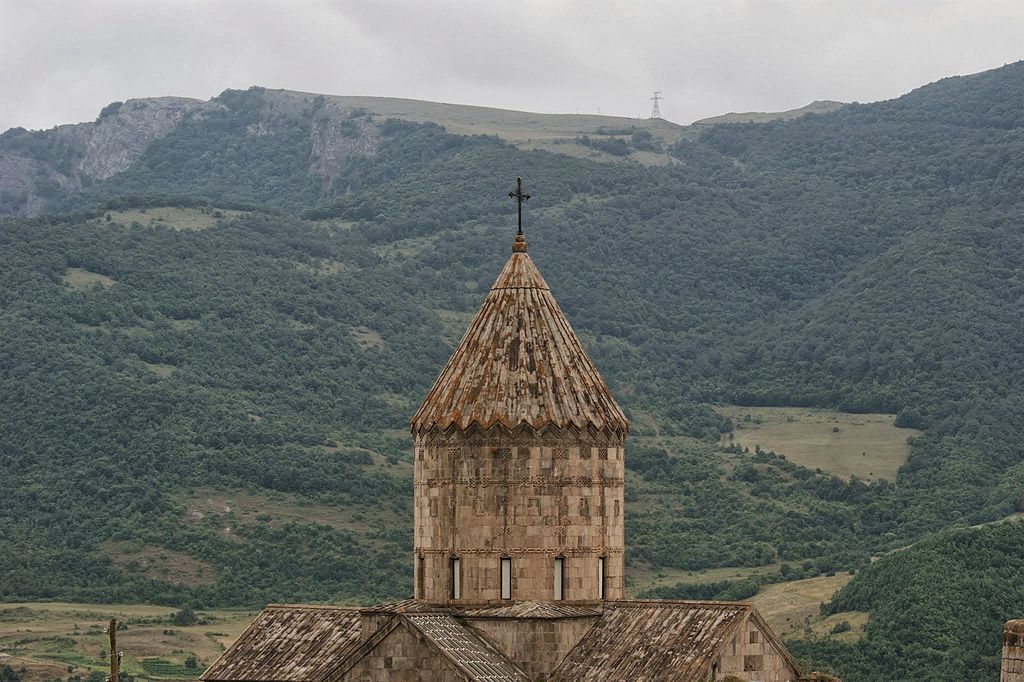
Just about every church built by the Armenian People features a large central space topped with a dome. This format is not unique to Armenian Architecture, and many Eastern Orthodox Churches follow a similar plan. However, in Armenia, the conical roof is what really distinguishes these buildings from others throughout Eastern Europe. The design is largely practical, to help shed off the snow that frequently falls in the winter months. But beyond the functional aspect of a conical roof, the design also creates a pinnacle that can be seen from a great distance, thus allowing these churches to be seen from miles away across the rugged Armenian terrain. Here at the Tatev Monastery, the conical roof is split into a series of triangles, creating a fanned series of ridges and valleys.
Stark and Bare Interiors
Photo by Tiia Monto from Wikimedia Commons

Many Armenian churches and monasteries share a distinct lack of color and ornamentation, particularly on the interior. This was often an intentional design choice, which allowed worshippers to focus on the religious ceremonies, rather than be distracted by flashy decorations. Although there are many exceptions to this, a great number of Armenian Churches all share this characteristic. The Haghpat Monastery is a great example. Here, the interior is dark without color or artwork of any kind. It would seem like a sad and gloomy space if it weren’t for the light pouring in from the oculus above, which many believe was a conscious design choice to symbolize the light of the heavens brightening up the world below.
Byzantine, Persian, and Islamic Influences
Photo by Dosseman from Wikimedia Commons
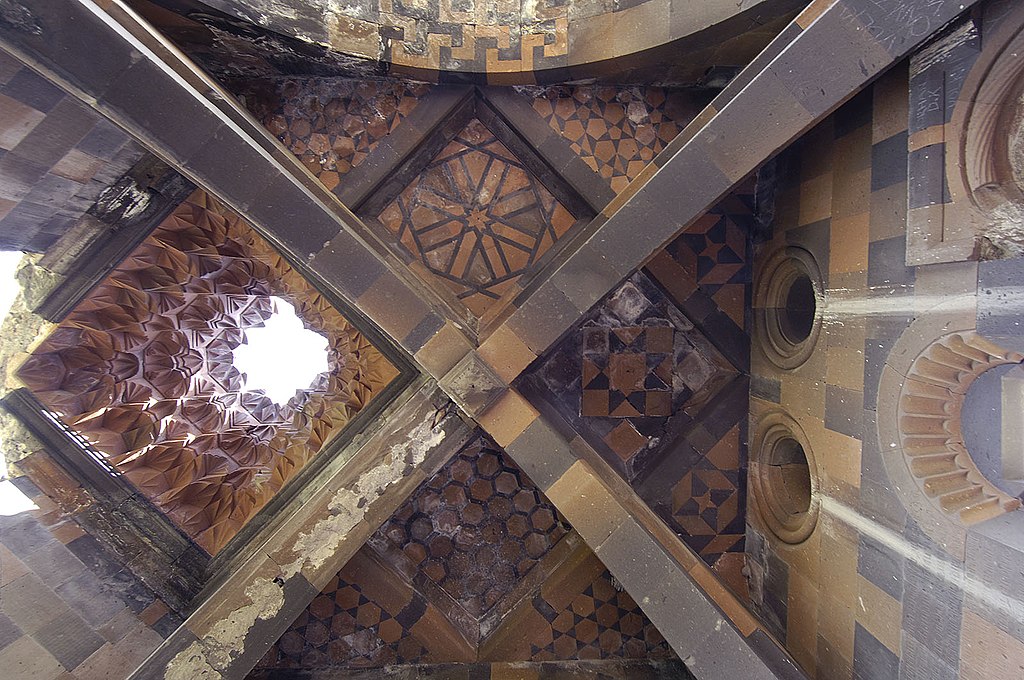
Thanks to the multitude of different rulers that controlled the region, Armenian Architecture borrows elements from several other cultures. The Haghpat Monastery is famous for its colorful Byzantine-Style frescoes, which are a rarity in Armenian Buildings. Many different features from Islamic Architecture are also prevalent in Armenian Buildings. For instance, here at the Church of the Holy Apostles in Ani, the ceiling is richly decorated with geometric stonework that resembles the detailing in mosques throughout the Middle East. The geometric vaulting at the left side of the image is known as “Muqarnas” and it’s used to create a small but impressive dome within the church’s interior.
What are the best examples of Armenian Architecture?
Below is a list of buildings that are often regarded as the best examples of Armenian Architecture. Although many of these buildings aren’t located within modern-day Armenia, they were still built by the various Armenian Kingdoms that once ruled their own sovereign nations.
1. Etchmiadzin Cathedral – Vagharshapat, Armavir, Armenia
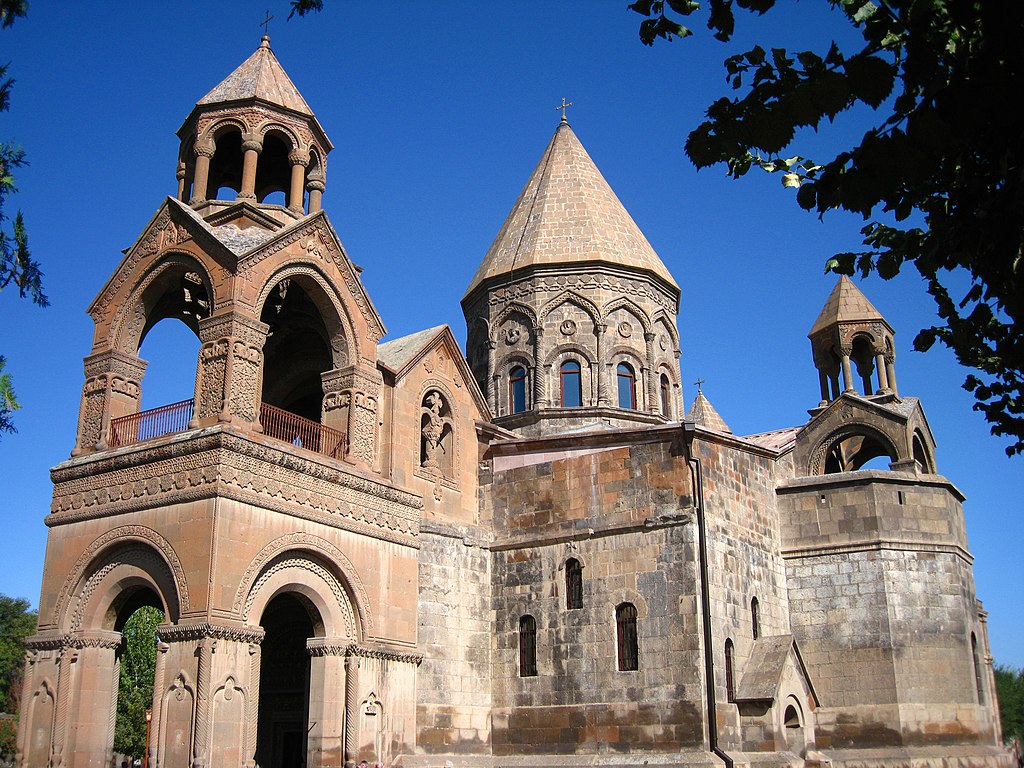
Vagharshapat is the fourth-largest city in Armenia and is home to some of the nation’s most impressive churches. Etchmiadzin Cathedral is the city’s most significant church, and it was completed in 301 CE, making it the oldest cathedral in the world. The church was founded by one of Armenia’s most powerful monarchs, King Tiridates III. It was added to and modified over time. The central portion of the building is the oldest, with the large entrance portico and some of the adjoining chapels added later on.
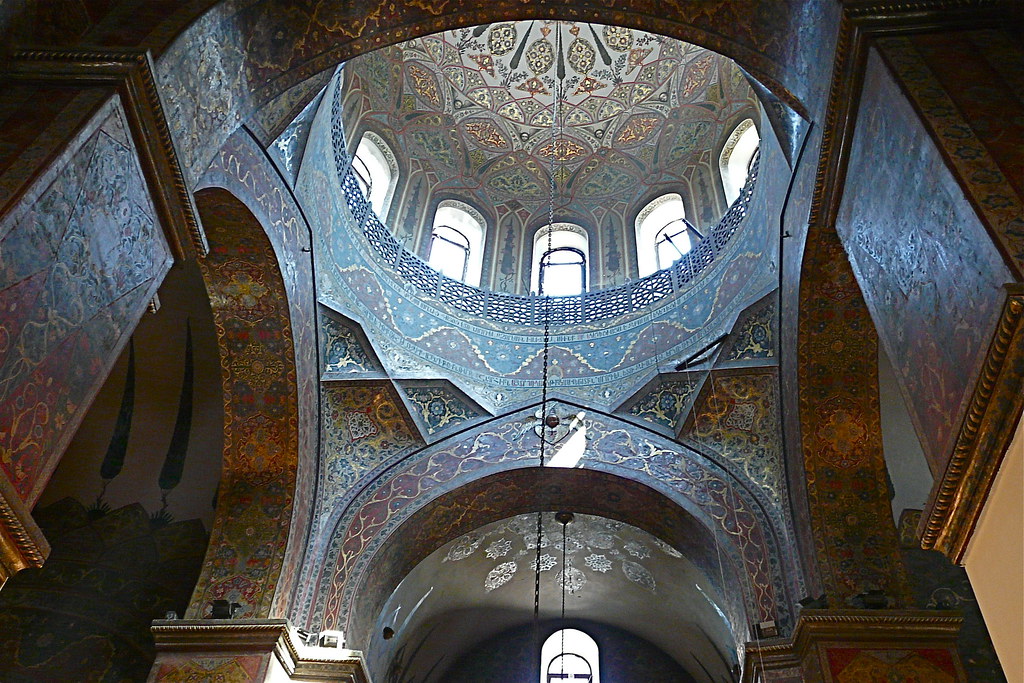
The interior of the church is richly decorated with colorful geometric designs that were heavily influenced by works of Islamic Architecture, such as the mosques of the Ottoman Empire. This makes Etchmiadzin Cathedral unique because many older Armenian churches still feature dark colorless interiors. Today, the Etchmiadzin Cathedral is the leading church for the entire Armenian Apostolic Church, and many modern-day Armenians who live abroad make a point to visit the church in their lifetimes.
2. Geghard – Goght, Kotayk, Armenia
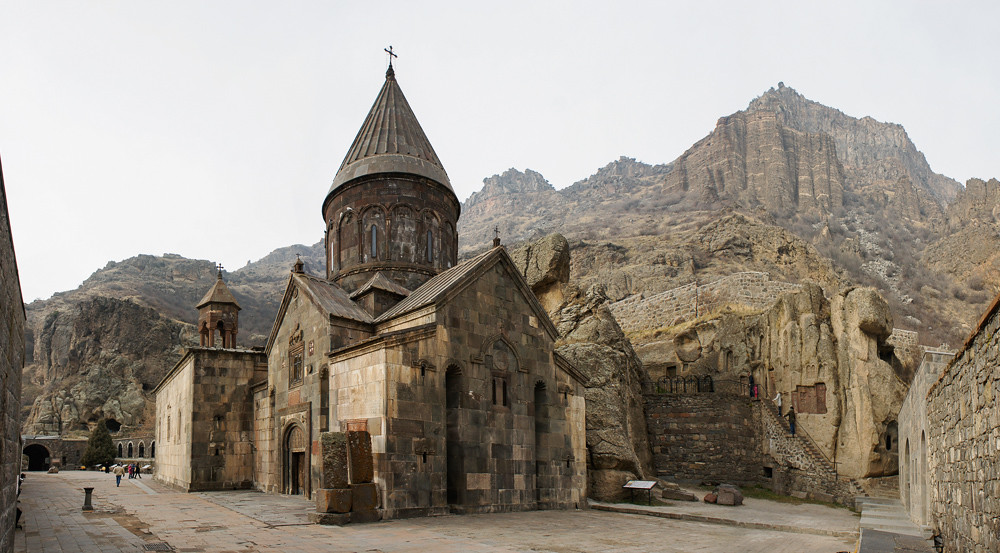
Throughout Armenia, you will find many different isolated monasteries, some of which date all the way back to the ancient Kingdom of Armenia. Located high in the mountains, Geghard Monastery is one of the most impressive of all of these. A group of monks began work on the site in the 4th century, but the main church at the center of the compound dates from the 13th century. Like a lot of other monasteries in the region, Geghard contains many different buildings, including the main church, several smaller chapels, tombs, spaces for the monks to live, and a small fortified wall to protect the inhabitants.
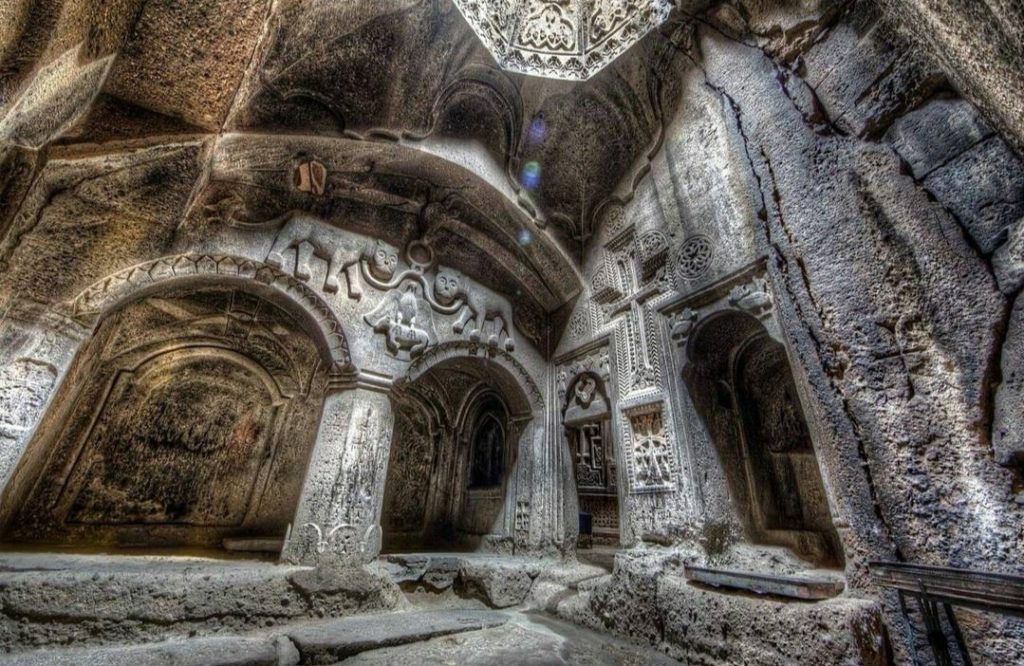
Geghard Monastery has one of the more ornately carved interiors of any of the buildings on this list, and a few of the chapels within the complex are actually cut from sold rock within the adjacent hillside. The monastery was an important pilgrimage site for centuries, and it was said to contain many historic religious relics. Today the entire Monastery of Geghard is protected as a UNESCO World Heritage Site.
3. Ruins of Ani – Kars Province, Eastern Anatolia, Turkey
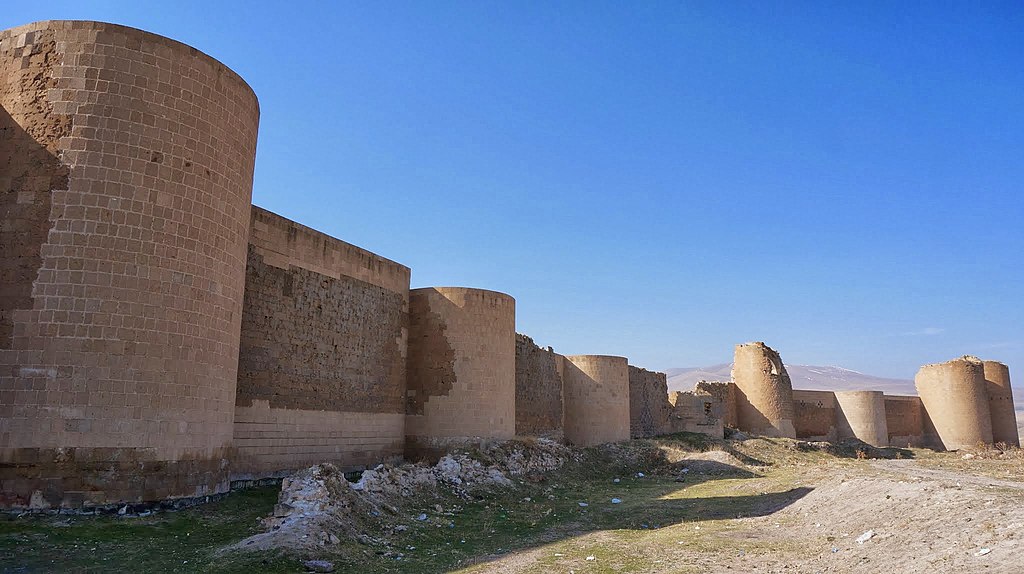
Ani was once one of the grandest cities on earth. The city boasted an impressive fortification system, countless churches and monuments, and it was an important stop on the east-to-west trade routes that connected Europe with the Middle East and Asia. The city was said to be so wealthy and full of incredible works of architecture that it earned itself the nickname “the city of 1001 churches.”

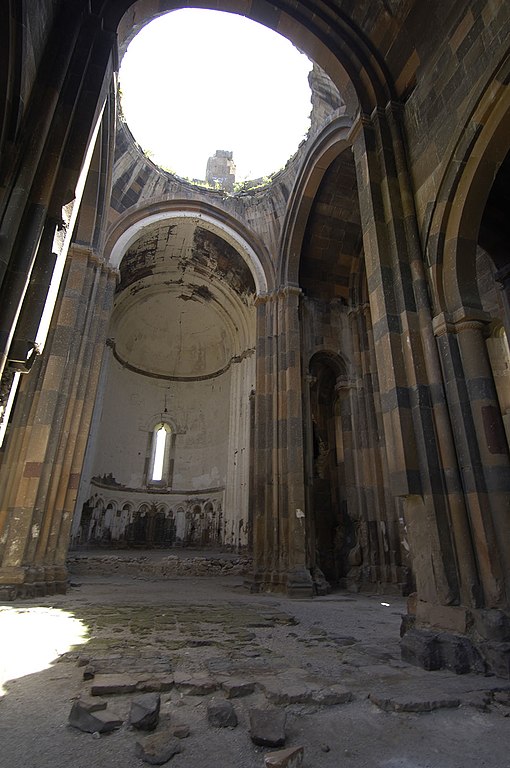
The Mongol Empire, which had rapidly expanded in the middle ages, sacked Ani in 1236, leaving the once-great city a desolate wasteland. The city was subsequently abandoned, and today, all of the site’s incredible buildings are nearly unrecognizable. Portions of the fortified wall, the Church of the Holy Redeemer (left above), and the Cathedral of Ani (right above), provide a glimpse at the city’s one great appearance. Today, the Archaeological Site of Ani is listed as a UNESCO World Heritage Site.
4. Saint Hripsime Church – Vagharshapat, Armavir, Armenia
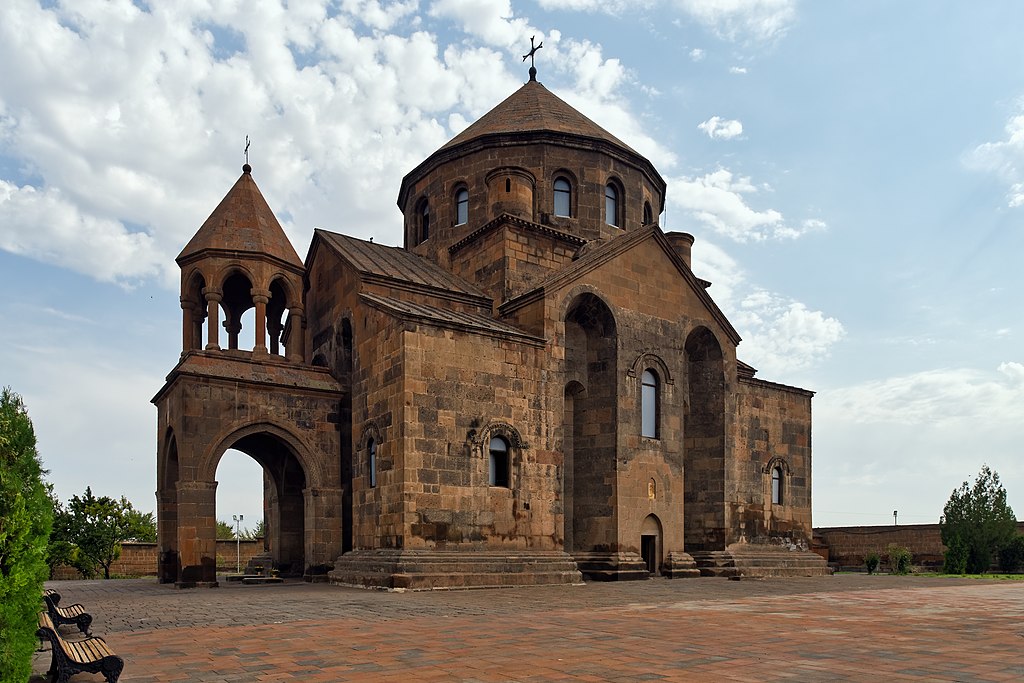
Dating from the 7th century, Saint Hripsime Church is another famous religious building located within Vagharshapat. Like a lot of early Armenian Churches, the oldest portion features a cruciform plan with a central space topped with a dome. The building also greatly resembles other works of European Romanesque Architecture, thanks to the rounded arches, small windows, and thick, sturdy walls.
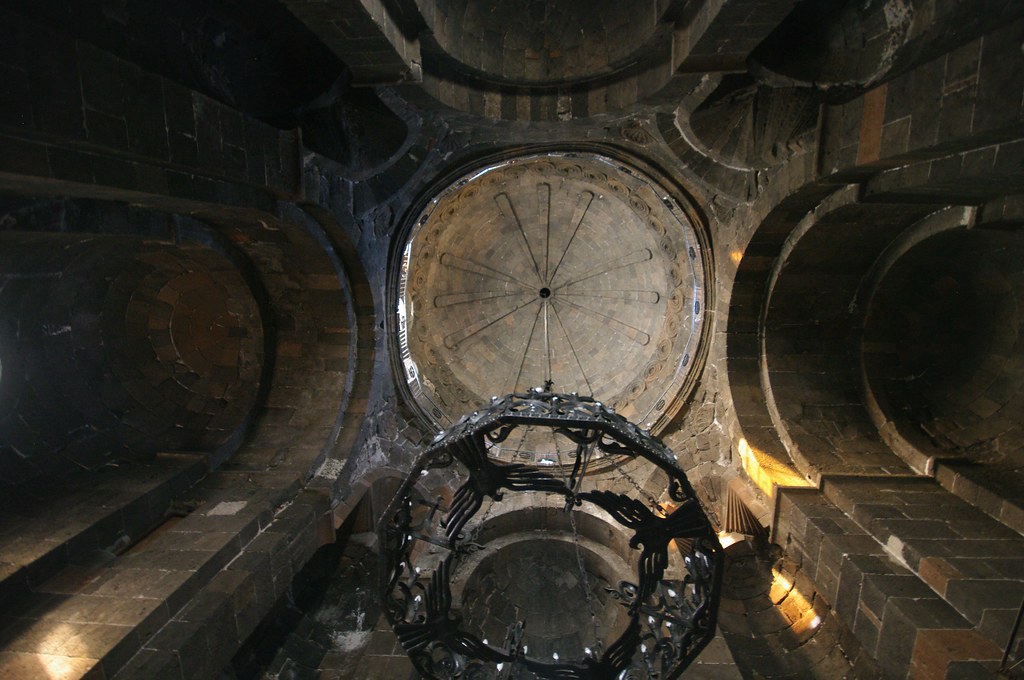
The main interior space looks the same way it would have centuries ago. The dark masonry contrasts with the natural light that comes in through the windows beneath the dome. Saint Hripsime Church served as a prototype for many other churches built throughout Armenia, Georgia, and the rest of the Caucasus region. Today, along with all of the other churches on this list located in Vagharshapat, Saint Hripsime Church is part of the “Cathedral and Churches of Echmiatsin and the Archaeological Site of Zvartnots” UNESCO World Heritage Site.
Like Architecture of Cities? Sign up for our mailing list to get updates on our latest articles and other information related to Architectural History.
5. Ruins of Corycus – Kızkalesi, Mediterranean Region, Turkey

From 1080 CE – 1375 CE the Armenian Kingdom of Cilicia was one of the most powerful states in the Eastern Mediterranean. Corycus was once one of the kingdom’s most important strongholds, and it contained both a sea castle which was located on an island off the shore, and a land castle that protected the harbor. Although both castles were abandoned centuries ago, large portions of them still remain. Armenian Military Architecture at this time period was heavily influenced by the European Crusaders, who frequently visited the kingdom on their way to Jerusalem and the Holy Land.

The castles of Corycus were built at a time before gunpowder, and therefore have many of the same features as other medieval castles. The sea castle in particular had a reputation in the middle ages as being one of the most impenetrable castles in the kingdom. After the fall of the Kingdom of Armenian Cilicia, the castles at Corycus fell into the hands of many different nations, and they eventually became an important outpost for the Ottoman Empire.

The Crusades were very influential in the development of the Eastern Mediterranean, and many of the region’s most impressive fortifications were constructed during this period. Check out our article on The Castles of the Crusades to learn more!
6. Tatev Monastery – Tatev, Syunik, Armenia

Tatev Monastery is one of the most famous monasteries in all of Armenia, thanks in large part to its striking location. Its located on a cliff’s edge overlooking a large valley. At the time it was founded, the monastery was located far from any major settlements. The monks in the monastery wanted to live an isolated lifestyle and therefore chose this remote spot that was naturally protected on several sides.
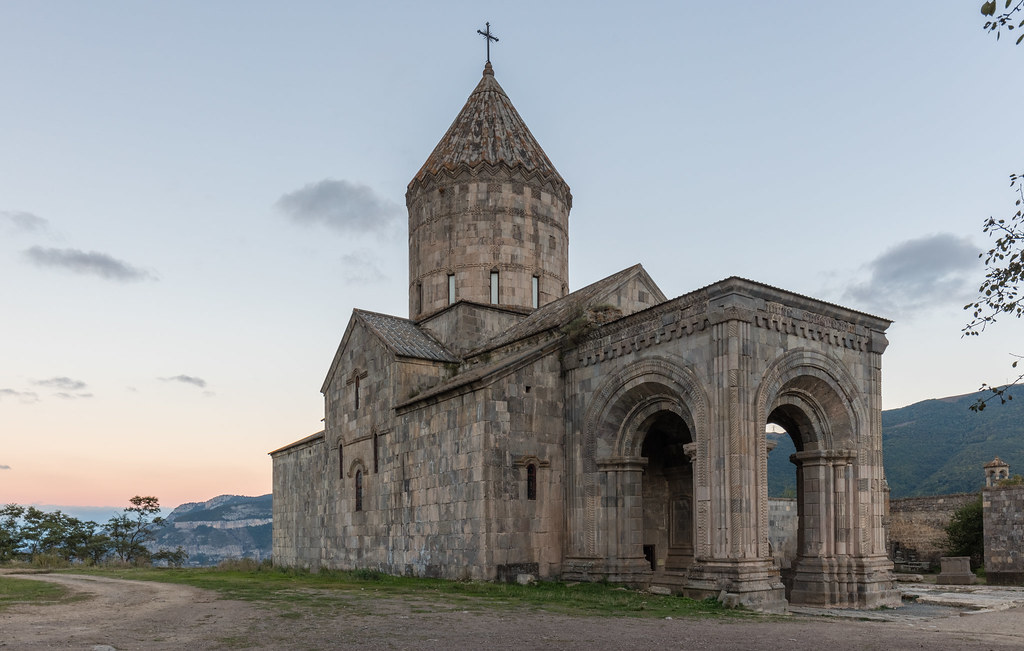
The main church contains a massive dome that is topped by a conical roof. This particular conical roof is geometric, and the overall cone is divided into a series of triangles. Conical Roofs are a key feature in Armenian Architecture and most of them are either geometric, like the one at Tatev Monastery, or they are rounded, like the one on the next church on the list.
7. Haghpat Monastery – Haghpat, Lori, Armenia

Haghpat Monastery is a UNESCO-Listed site located in the Armenian countryside. The monastery was built from the 10th – 13th century, and it contains all of the typical features of Armenian Architecture. The main church is built in a cruciform plan with a central dome. The dome is topped with a conical roof, and the entire church is built with thick and stout walls. The Armenians built a lot of their buildings with thick walls and tiny windows, partly to protect them from the region’s frequent earthquakes.
8. Saint Gayane Church – Vagharshapat, Armavir, Armenia

Another of Vagharshapat’s amazing Armenian-style churches is Saint Gayane Church. The church’s foundation was built in the 7th century on the site where an early Christian Martyr was killed in the 4th century. The church is built from a type of volcanic stone that is found throughout Armenia. This type of masonry can often have a pinkish or orangeish hue, which is a key characteristic of Armenian Architecture.
9. Kecharis Monastery – Tsaghkadzor, Kotayk, Armenia
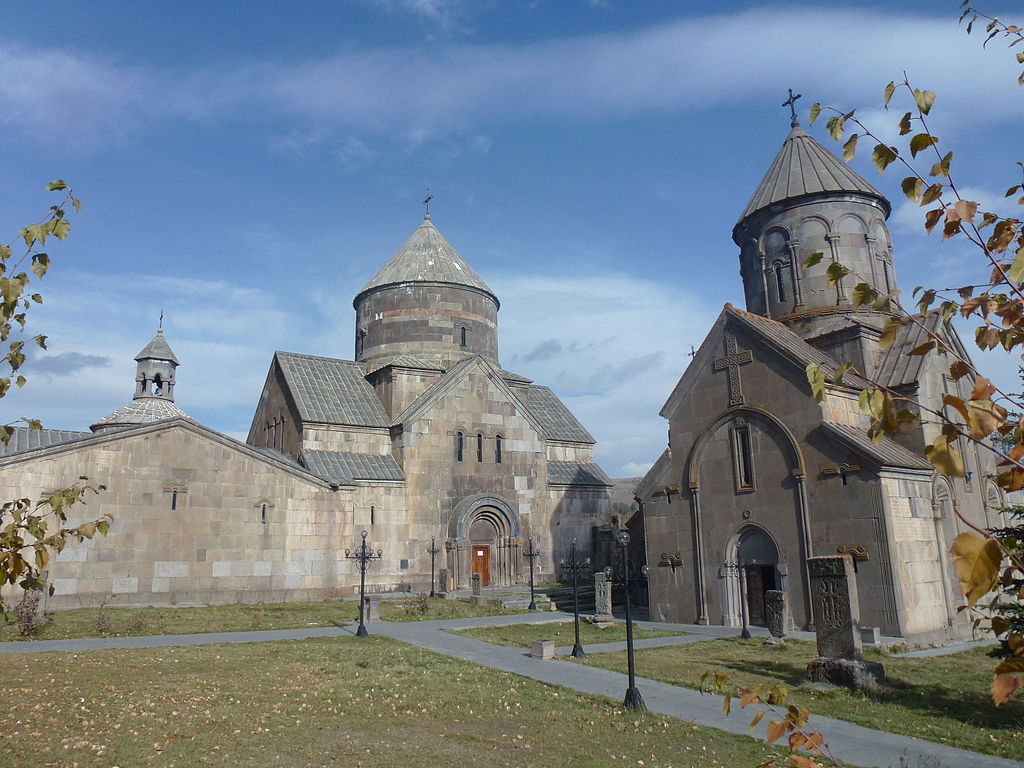
Tsaghkadzor is a town located in the mountains of central Armenia. It’s a popular tourist attraction for both local and international visitors thanks to its many ski slopes and spas. Kecharis Monastery, which dates originally to the 11th century, is one of many fantastic works of Armenian Architecture located in the area. The cylindrical walls beneath the domes have masonry that’s a different color than the rest of the stonework – and that’s because the two domes were heavily damaged in an earthquake in 1927. Restoration work took several decades, and the final touches weren’t completed until the year 2000.
10. Makaravank – Achajur, Tavush, Armenia
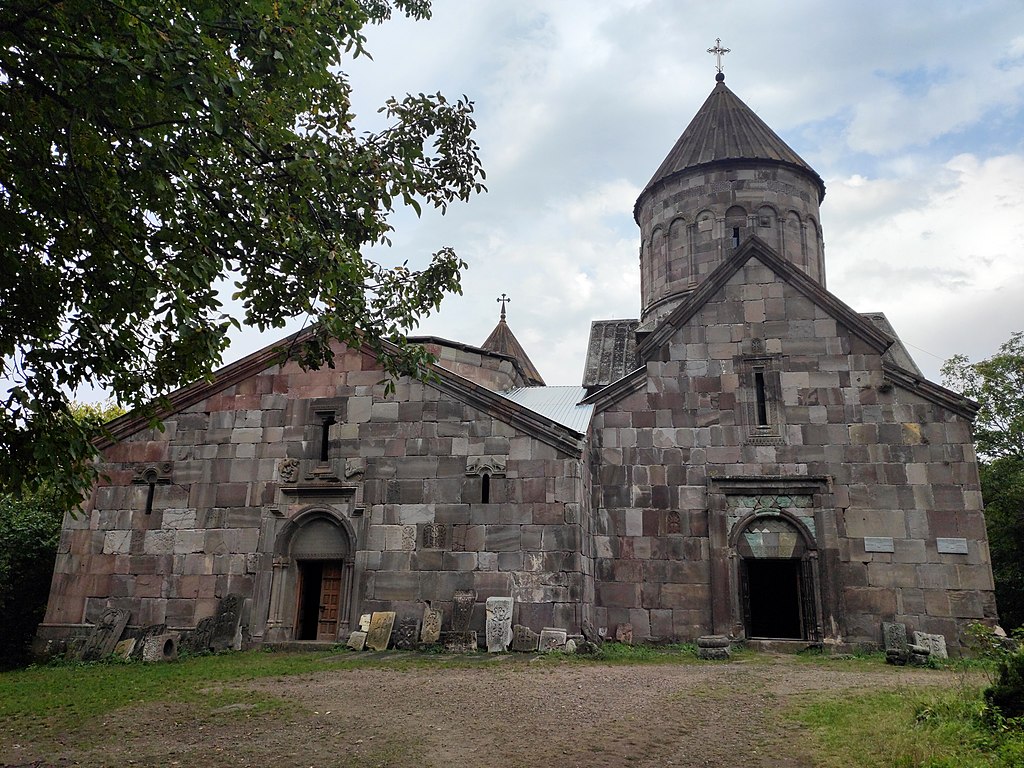
Makaravank is another Armenian Monastic Complex, located near the northern border with Azerbaijan. Just like many of the other Armenian Monasteries on this list, Makaravank is a collection of various buildings, the oldest one dating from the 900s. The site’s main church was mostly built in the year 1205, There is a Gavit, (also known as a Narthex) connecting a few of the buildings together. The site is known for the many Khachkars that were built by the monks, a few of which can be seen leaning against the front of the building in the above photo.
11. Sanahin Monastery – Sanahin, Lori, Armenia
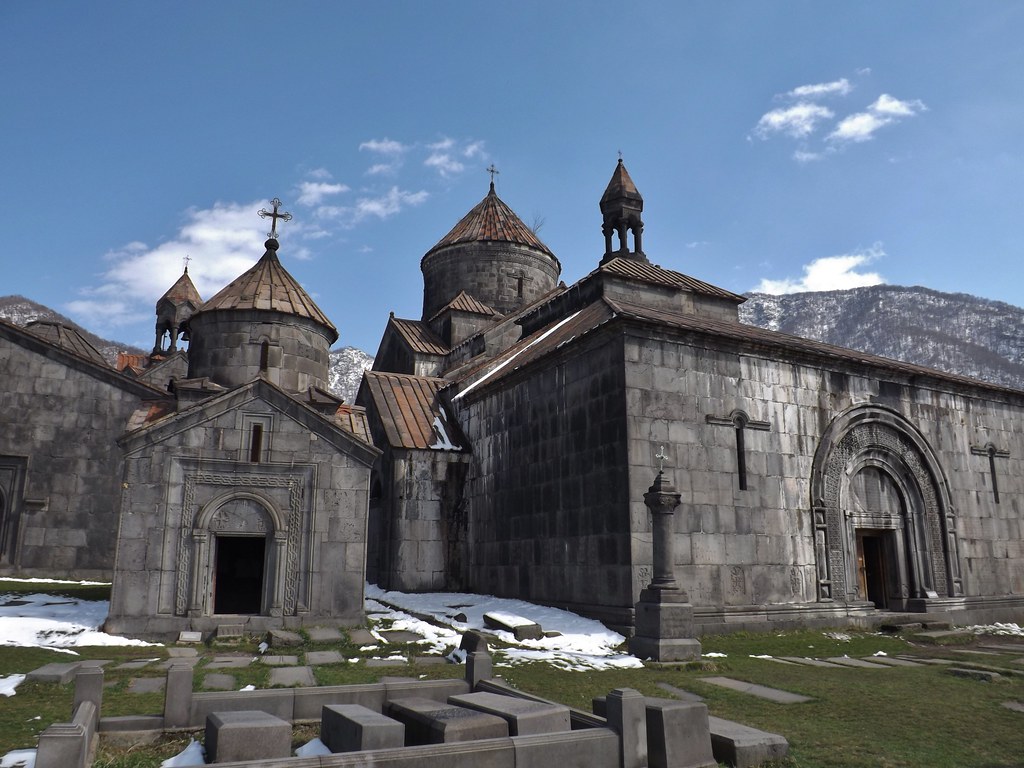
Sanahin Monastery, which is grouped together with Haghpat Monastery to form a UNESCO World Heritage Site, is another one of Armenia’s many monastic settlements. Its made out of a dark volcanic stone that is found throughout the mountains of the Caucasus. The various buildings in the complex all have the typical features of Armenian Architecture. Most of the churches and chapels have a central domed space, which are all topped with conical roofs. The windows are also narrow and look a lot like the arrow slots you can find in medieval castle construction. Although many Armenian Monasteries weren’t built to act as fortifications, many of them still had defenses to protect the inhabitants from the various groups that fought for control of the Caucasus over the centuries.
12. Zvartnots Cathedral – Vagharshapat, Armavir, Armenia

If it wasn’t in ruins, Zvartnots Cathedral would probably have the #1 spot on this list, but unfortunately, the church is just a shadow of its former self. The church was built all the way back in the 600s, but it only stood for a few hundred years before it collapsed in the 10th century. Experts disagree on how the church was destroyed, but the two leading theories are a collapse triggered by an earthquake or as a result of raids from the Arab invaders from the south. Regardless of the reason, it’s a shame the church is destroyed. Zvartnots Cathedral was a marvel of architecture and engineering, and it was built when much of Europe was still struggling through the Dark Ages. You can watch this video to see what the church looked like in its original form.
13. Gandzasar Monastery – Vank, Kalbajar, Azerbaijan

The Armenians once controlled large areas in between the Black and the Caspian Seas, and the Ancient Kingdom of Armenia once stretched all the way to the Mediterranean. This is why so many important Armenian buildings are located outside the borders of modern-day Armenia. Gandzasar Monastery is located within Azerbaijan, a country taking up most of Armenia’s eastern border. It was built between 1216 & 1238, during a turbulent time in Armenian history. The Great Seljuk Empire had seized control of medieval Armenia by the year 1092, which led to a series of conquests of Armenia, including the Mongol Invasions of the 1200s.
14. Yılankale – Yılankale, Mediterranean Region, Turkey
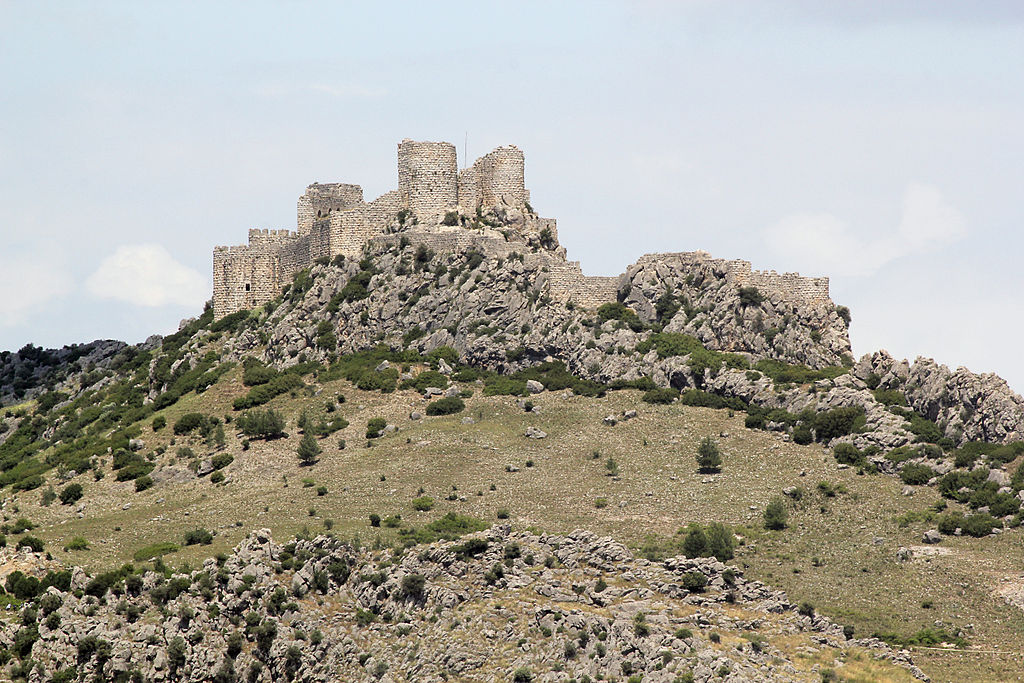
The Armenian Kingdom of Cilicia was formed when refugees fled Armenia after the invasion of the Seljuk Turks. The Armenians settled in Cilcia, an area in southern Turkey, along the Mediterranean Sea. They allied themselves with other nearby Christian states, such as the Kingdom of Cyprus, the Principality of Antioch, and the Byzantine Empire. There is a clear connection between the castles built by the Armenian Kingdom of Cilicia and other Crusader Castles located throughout the Middle East.
15. Saghmosavank – Saghmosavan, Aragatsotn, Armenia

Saghmosavank is another monastic complex located in Armenia. The site is located on the edge of a steep ravine made by the Kasakh River. The main church shows all the main features of Armenian Architecture, and thanks to its isolated location it remains remarkably well preserved. The orange-tinted stone beneath the conical roof is found throughout the buildings of Armenia.
Armenian Architecture Outside of Armenia
The influence of Armenian Culture and the Armenian Apostolic Church can be found throughout the rest of the world. Works of Armenian Architecture can be found in many different nations, many of which have strong Armenian populations.
One great example of an Armenian-style building being built far outside of the historic region of Armenia is the Armenian Cathedral of Lviv. Lviv is a city located in modern-day Ukraine, and Armenian immigrants built the church from 1363-1370 during a time when Lviv was part of the Kingdom of Poland.
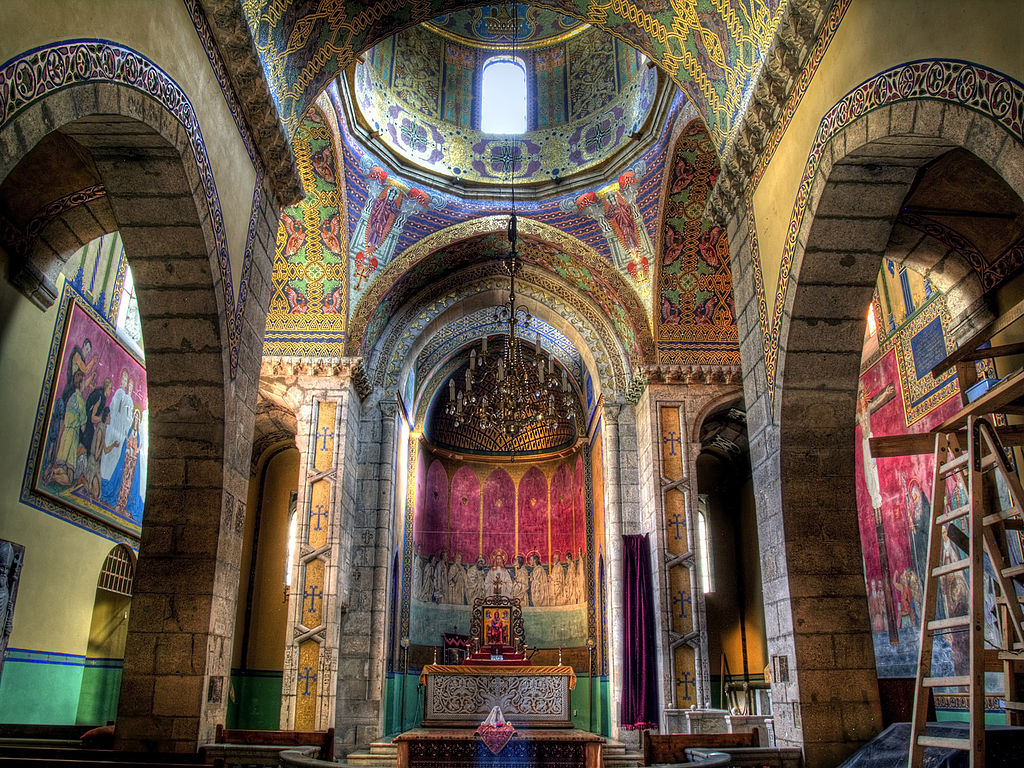
The interior of the Armenian Church in Lviv Ukraine is richly decorated with colorful images and tiles that were added long after the church was originally built in the 14th century.
Because Armenia was controlled by both the Russian Empire and the Soviet Union in the 19th-20th century, many works of Armenian Architecture can be found throughout modern-day Russia. There is a sizable Armenian community within the Russian capital, Moscow. The Armenian Cathedral of Moscow is an entire church dedicated to the local Armenian population living in the city. Although the church is fairly new, only being completed in 2013, it is built to resemble some of the finest Armenian Buildings from the Middle Ages.
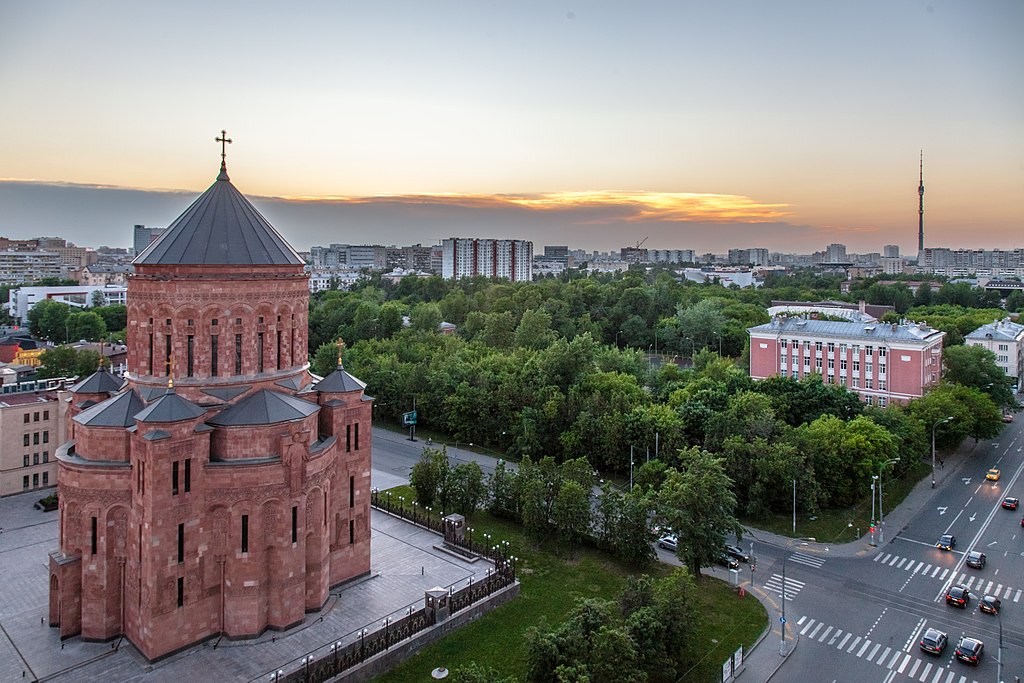
The brand new Armenian Church in Moscow, which was built from 2006-2013, shows just how incredible some of the now-ruined churches of Armenia might have looked during the Middle Ages. It’s easy to imagine the beauty of a place like Ani if you picture it filled with buildings that look just like this.
Modern Armenian Architecture
Armenia’s historic past has had an important impact on the nation’s modern architecture. Although the Republic of Armenia was only founded in 1991 after the fall of the Soviet Union, the nation is still constantly building new and impressive monuments, which borrow characteristics from much older Armenian Buildings.
Saint Gregory the Illuminator Cathedral in the Armenian capital Yerevan is a massive church that was consecrated in 2001. It was completed on the 1700th anniversary of the year Armenia was proclaimed a Christian nation in 301 CE. The church can accommodate nearly 2,000 people, and it is an important symbol of the rebuilding efforts of the post-Soviet era.
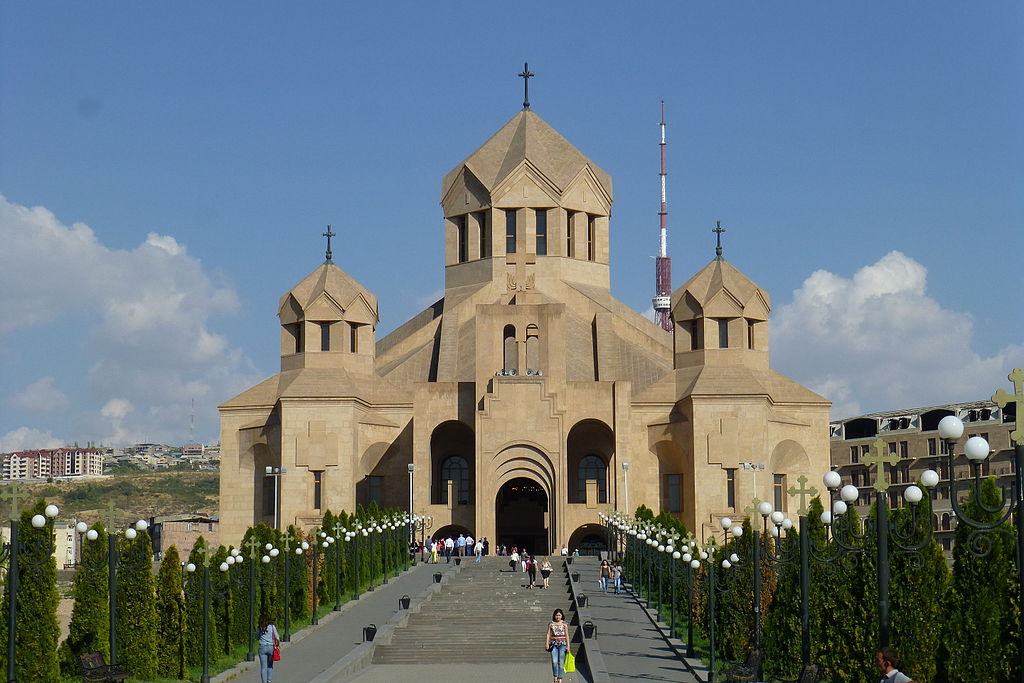
The Yerevan Cascade is another piece of Modern Architecture located within the Armenian Capital. Built mostly during the 1970s, it was designed to connect two different neighborhoods in a practical and elegant way. The exterior staircase is made of limestone and it features fountains and sculptures periodically placed along the pedestrian pathways. Beneath the exterior staircase, there are several escalators that weave through different art and history exhibits. Today. locals call the entire area around the stairs the Cascade Neighborhood, and it’s a popular attraction for the residents of Yerevan.
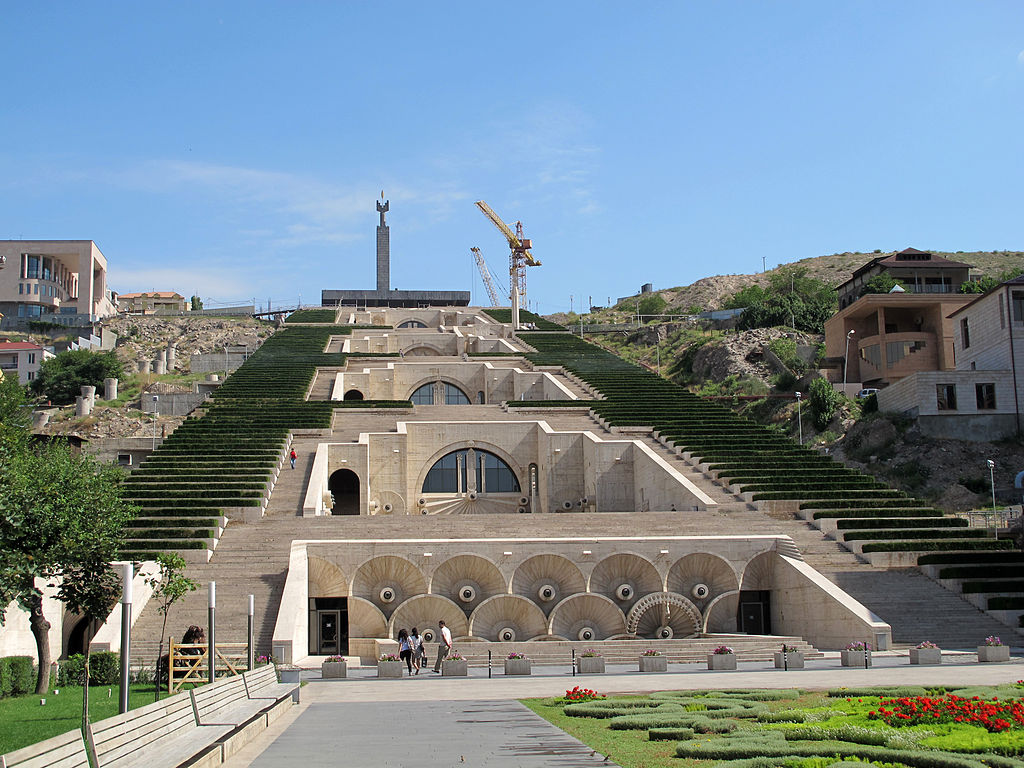
The Cascade is one of the most popular public places in Yerevan. The construction cranes seen at the top of the image above show how the area is still being developed within the heart of the modern Armenian capital.
Gyumri is the second-largest city in Armenia, and it was a leading city in the region, rivaling Yerevan when Armenia was part of the Russian Empire. The city was known as Alexandropol through the 19th century, during a time when many imposing buildings were built. The Holy Saviour’s Church of Gyumri was completed in 1873, and it was built to match many of the historic works of Armenian Architecture from medieval Armenia. The builders took great care in selecting stones that worked for the two-tone color scheme that combines orange-colored volcanic tuff stone with other dark stones. The church also looks very pristine nowadays. thanks to a lengthy restoration that took place after the Great Armenian Earthquake of 1988.
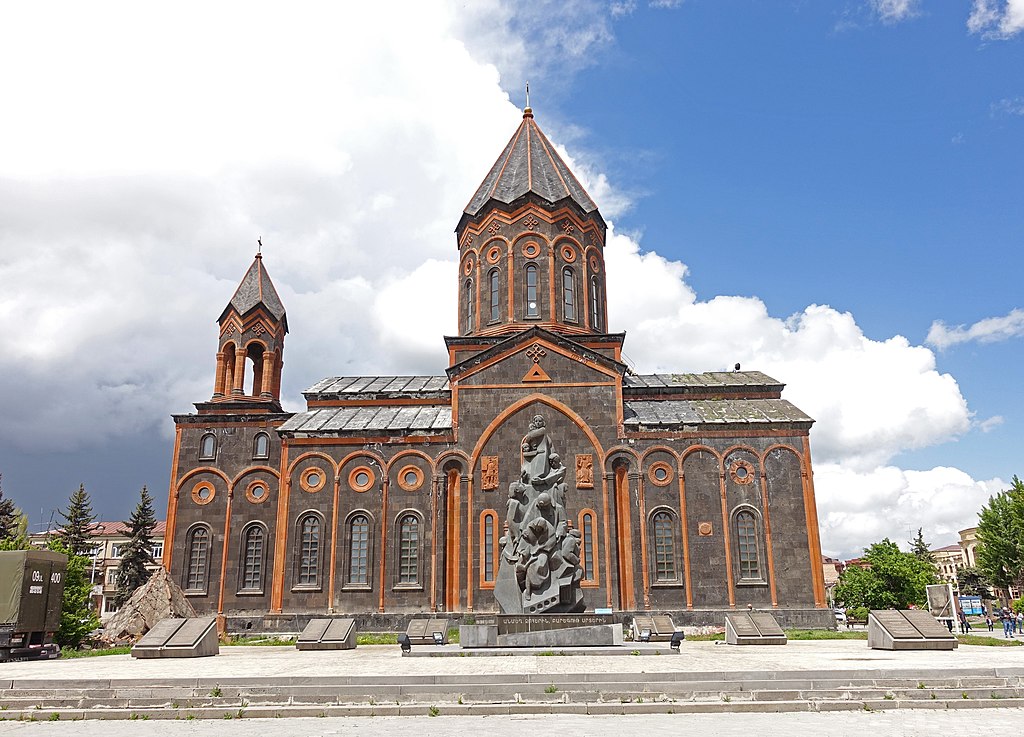
Although the Church of the Holy Savior in Gyumri was built in the 19th century, it still contains all of the key features of Armenian Architecture from the former Kingdoms of Armenia.
Armenia also utilizes modern architecture to commemorate important events from the nation’s past. During WWI, the Ottoman Empire began a program of ethnic cleansing and forced the migration of nearly 1 million ethnic Armenians. Many of these people were pushed out of their homes and were often murdered if they caused any trouble for the Ottoman Army. The event, now known as the Armenian Genocide, is immortalized in the Armenian Genocide Memorial and Museum in Yerevan.
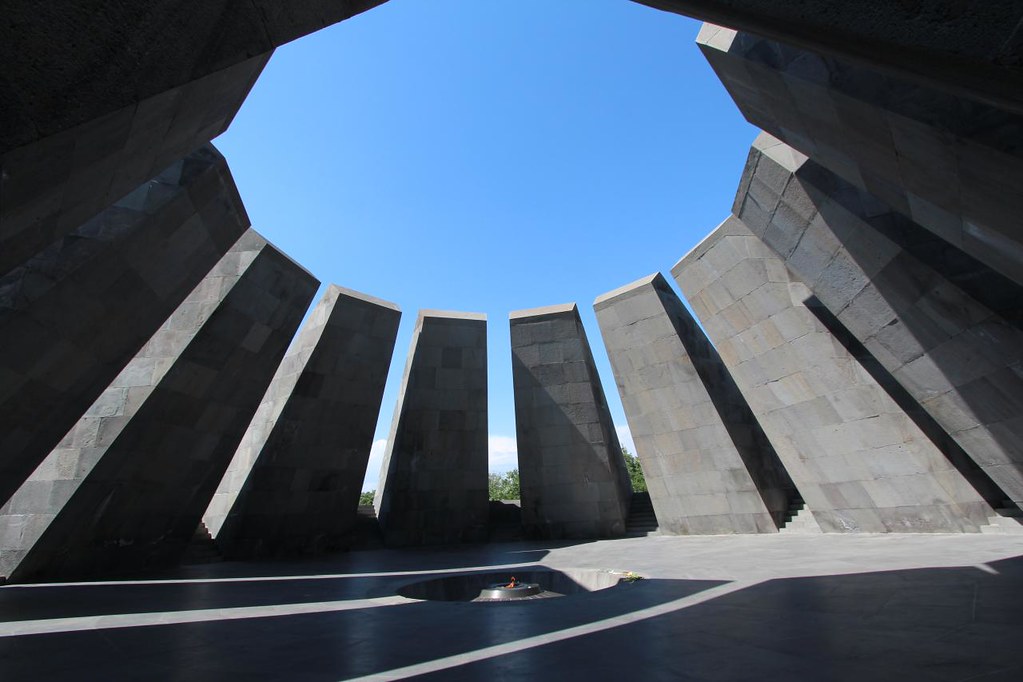
Armenian Architecture Today
Armenia was a formidable kingdom during antiquity, and the Armenian people lived on to begin many important dynasties over the centuries. This helped spread Armenian Culture and customs throughout the Caucasus, Anatolia, and the Eastern Mediterranean. The Armenians perfected many building techniques through the construction of their churches and monasteries, and these developments are still influencing architecture to this day. Today, millions of Armenians live in The United States, Europe, and the Middle East, and Armenian Architecture lives on both in the Armenian Homeland and the rest of the globe.

- About the Author
- Rob Carney, the founder and lead writer for Architecture of Cities has been studying the history of architecture for over 15 years.
- He is an avid traveler and photographer, and he is passionate about buildings and building history.
- Rob has a B.S. and a Master’s degree in Architecture and has worked as an architect and engineer in the Boston area for 10 years.
Like Architecture of Cities? Sign up for our mailing list to get updates on our latest articles and other information related to Architectural History.
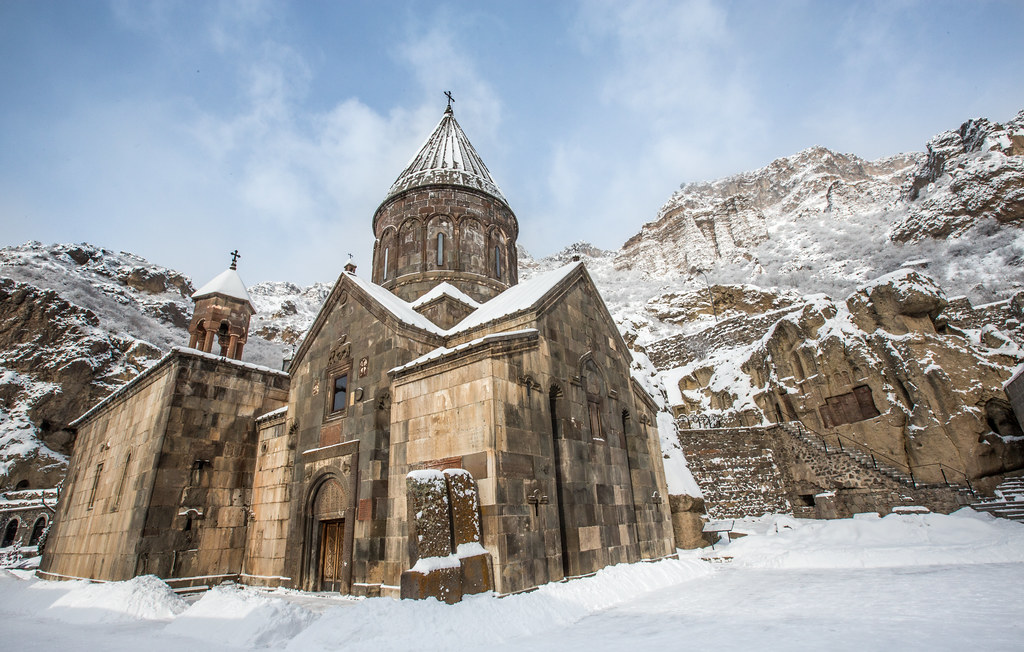
Photo by Raffi Youredjian from flickr
